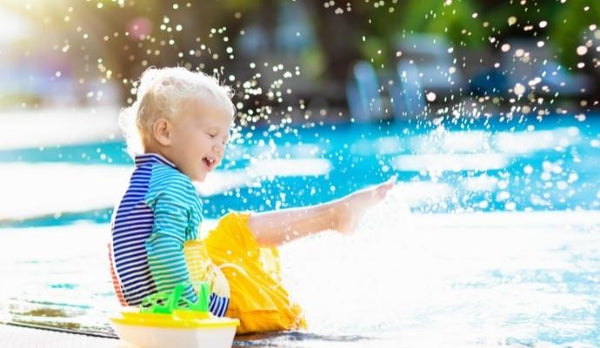
Playing in the water is always a big part of summertime fun! Practicing water safety is essential for parents and caregivers to know, as babies are extra vulnerable. Whether you’re at the pool in your own backyard or at the beach, here’s some tips to know to protect your baby when he or she is near the water.
Always Have an Eye on Your Baby
Plain and simple, you should always supervise your child when they play in or around water. Drowning can happen quickly and silently – even with less than 1 inch of water, a baby could drown.
Use “Touch Supervision”. Stay within an arm’s length of your baby when it’s bath time or if you’re swimming together. An arm’s length distance will give your little one space to enjoy the water, but when you need to get out of the water, take your child with you.
Assign a “Water Watcher”. If you’re at a pool party or having fun at the lake or beach, have one adult constantly watching the little ones playing. This adult should be distraction free, so no phones or drinks as they supervise. You may think this is unnecessary if there are lifeguards present, but there could be too many people in the water for the lifeguard to keep an eye on.
Take turn with other parents in your group, and take breaks! Constantly keeping an eye on children during a fun summer party can get exhausting, so switch out with another parent every so often. Older children should not be supervising younger children – it’s best to have an adult be the water watcher.

Wear a fitting life jacket
When playing in or around natural bodies of water, your child should always wear a fitting life jacket. Due to strong currents in the water, there is always the risk of being pulled away. Even if your child has taken swim lessons and is a capable swimmer, water currents can easily overwhelm your child.
The American Academy of Pediatrics (AAP) encourages babies to wear a life jacket when they are around water, even if you don’t intend for him or her to enter the water. For babies and children who can’t swim, open water is dangerous. Despite wearing a life jacket, you should always supervise your baby.
A fitting life jacket for your infant should have no gaps when it’s worn. It shouldn’t rise above your child’s chin or ears. Your little one may not like the bulkiness of the life jacket, and can find it awkward to wear. Since children often learn by example, you can have yourself or another child wear on the life jacket to show how it should be worn.
Establish Pool Rules
If you have a pool, educate your children and make ground rules. For example, no running and roughhousing around the pool; never dive without an adult supervising; wear a life jacket if needed.
Make sure your babysitter or caregivers are aware of your pool rules and can enforce it.

Be Prepared
Since anything can happen, it’s important that you learn CPR or the Heimlich maneuver. Be ready to respond if there are any incidents that occur. Keep a first-aid kit on hand if you plan to be at the beach or lake.
To prevent your little one from wandering into your backyard pool, install fencing surrounding the pool with a latching gate that is out of a child’s reach. If you have an above-ground pool, remove any ladders to discourage climbing. Also, bring all of the pool toys out of the pool when everyone has finished cleaning. Your little one may wander and try to retrieve them. Babyproofing your pool will save you from any future heartache.
When your child is old enough, consider signing up for swimming lessons. While knowing how to swim won’t completely prevent drowning, it can lower the chances of drowning occurring.
Resources:










Leave a comment